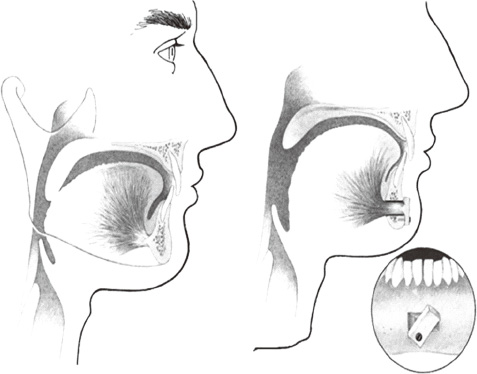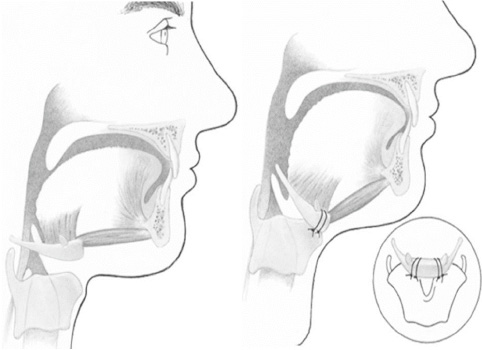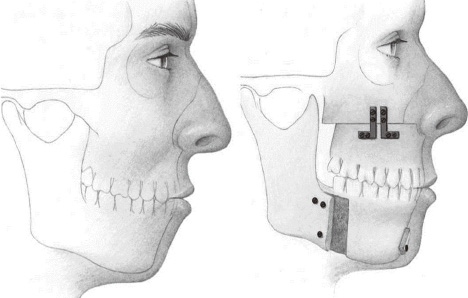Hanyang Med Rev.
2013 Nov;33(4):233-238. 10.7599/hmr.2013.33.4.233.
Skeletal Surgery in Obstructive Sleep Apnea
- Affiliations
-
- 1Department of Otorhinolaryngology-Head and Neck Surgery, Kyung Hee University School of Medicine, Seoul, Korea. drkimsw@hanmail.net
- KMID: 2284440
- DOI: http://doi.org/10.7599/hmr.2013.33.4.233
Abstract
- Skeletal surgery for obstructive sleep apnea (OSA) aims to provide more space for the soft tissue in the oropharynx to prevent airway collapse during sleep. Conventional surgical techniques include genioglossus advancement (GA), hyoid myotomy/suspension (HMS), and maxillomandibular advancement (MMA). GA and HMS are usually performed with soft tissue surgery and/or other skeletal surgery in a combined manner. These combined procedures seem to have a higher success rate. MMA employs a different conceptual approach, so called whole upper airway reconstruction, because MMA can widen the entire upper airway with one procedure. Various modifications of skeletal surgery have been reported. Surgical techniques, efficacy and complications of skeletal surgery with my opinions and comments are introduced in this review. Furthermore, limitations and considerations in skeletal surgery that sleep surgeons have to realize and overcome will be discussed in this review.
Keyword
Figure
Cited by 1 articles
-
Sleep and Health
Seok Hyun Cho
Hanyang Med Rev. 2013;33(4):187-189. doi: 10.7599/hmr.2013.33.4.187.
Reference
-
1. Aurora RN, Casey KR, Kristo D, Auerbach S, Bista SR, Chowdhuri S, et al. Practice parameters for the surgical modifications of the upper airway for obstructive sleep apnea in adults. Sleep. 2010; 33:1408–1413.
Article2. Powell NB. Contemporary surgery for obstructive sleep apnea syndrome. Clin Exp Otorhinolaryngol. 2009; 2:107–114.
Article3. Brevi BC, Toma L, Magri AS, Sesenna E. Use of the mandibular distraction technique to treat obstructive sleep apnea syndrome. J Oral Maxillofac Surg. 2011; 69:566–571.
Article4. Riley RW, Powell NB, Guilleminault C. Obstructive sleep apnea syndrome: a surgical protocol for dynamic upper airway reconstruction. J Oral Maxillofac Surg. 1993; 51:742–747. discussion 8-9.
Article5. Hendler BH, Costello BJ, Silverstein K, Yen D, Goldberg A. A protocol for uvulopalatopharyngoplasty, mortised genioplasty, and maxillomandibular advancement in patients with obstructive sleep apnea: an analysis of 40 cases. J Oral Maxillofac Surg. 2001; 59:892–897. discussion 8-9.
Article6. Emara TA, Omara TA, Shouman WM. Modified genioglossus advancement and uvulopalatopharyngoplasty in patients with obstructive sleep apnea. Otolaryngol Head Neck Surg. 2011; 145:865–871.
Article7. Riley RW, Powell NB, Guilleminault C. Inferior mandibular osteotomy and hyoid myotomy suspension for obstructive sleep apnea: a review of 55 patients. J Oral Maxillofac Surg. 1989; 47:159–164.
Article8. Powell N, Guilleminault C, Riley R, Smith L. Mandibular advancement and obstructive sleep apnea syndrome. Bull Eur Physiopathol Respir. 1983; 19:607–610.9. Riley RW, Powell NB, Guilleminault C. Obstructive sleep apnea syndrome: a review of 306 consecutively treated surgical patients. Otolaryngol Head Neck Surg. 1993; 108:117–125.
Article10. Kim SW. Sleep disordered breathing. Korean Society of Otorhinolaryngology-Head and Neck Surgery. Otorhinolaryngology-Head and Neck Surgery. Seoul: Ilchokak;2009. p. 1364–1388.11. Dattilo DJ. The mandibular trapezoid osteotomy for the treatment of obstructive sleep apnea: report of a case. J Oral Maxillofac Surg. 1998; 56:1442–1446.
Article12. Dattilo DJ, Aynechi M. Modification of the anterior mandibular osteotomy for genioglossus advancement with hyoid suspension for obstructive sleep apnea. J Oral Maxillofac Surg. 2007; 65:1876–1879.
Article13. Miller FR, Watson D, Boseley M. The role of the Genial Bone Advancement Trephine system in conjunction with uvulopalatopharyngoplasty in the multilevel management of obstructive sleep apnea. Otolaryngol Head Neck Surg. 2004; 130:73–79.
Article14. Hendler BH, Costello BJ, Silverstein K, Yen D, Goldberg A. A protocol for uvulopalatopharyngoplasty, mortised genioplasty, and maxillomandibular advancement in patients with obstructive sleep apnea: an analysis of 40 cases. J Oral Maxillofac Surg. 2001; 59:892–897. discussion 8-9.
Article15. García Vega JR, de la Plata MM, Galindo N, Navarro M, Díez D, Láncara F. Genioglossus muscle advancement: a modification of the conventional technique. J Craniomaxillofac Surg. 2013.
Article16. Li KK, Riley R, Powell N. Complications of obstructive sleep apnea surgery. Oral Maxillofac Surg Clin North Am. 2003; 15:297–304.
Article17. Kezirian EJ, Goldberg AN. Hypopharyngeal surgery in obstructive sleep apnea: an evidence-based medicine review. Arch Otolaryngol Head Neck Surg. 2006; 132:206–213.18. Riley RW, Powell NB, Guilleminault C. Obstructive sleep apnea and the hyoid: a revised surgical procedure. Otolaryngol Head Neck Surg. 1994; 111:717–721.
Article19. Richard W, Timmer F, van Tinteren H, de Vries N. Complications of hyoid suspension in the treatment of obstructive sleep apnea syndrome. Eur Arch Otorhinolaryngol. 2011; 268:631–635.
Article20. Baisch A, Maurer JT, Hormann K. The effect of hyoid suspension in a multilevel surgery concept for obstructive sleep apnea. Otolaryngol Head Neck Surg. 2006; 134:856–861.
Article21. Verse T, Baisch A, Maurer JT, Stuck BA, Hormann K. Multilevel surgery for obstructive sleep apnea: short-term results. Otolaryngol Head Neck Surg. 2006; 134:571–577.
Article22. Riley RW, Powell NB, Guilleminault C. Maxillofacial surgery and obstructive sleep apnea: a review of 80 patients. Otolaryngol Head Neck Surg. 1989; 101:353–361.
Article23. Li KK, Guilleminault C, Riley RW, Powell NB. Obstructive sleep apnea and maxillomandibular advancement: an assessment of airway changes using radiographic and nasopharyngoscopic examinations. J Oral Maxillofac Surg. 2002; 60:526–530. discussion 31.
Article24. Goh YH, Lim KA. Modified maxillomandibular advancement for the treatment of obstructive sleep apnea: a preliminary report. Laryngoscope. 2003; 113:1577–1582.
Article25. Goodday R, Bourque S. Subjective outcomes of maxillomandibular advancement surgery for treatment of obstructive sleep apnea syndrome. J Oral Maxillofac Surg. 2012; 70:417–420.
Article26. Liu SR, Yi HL, Guan J, Chen B, Wu HM, Yin SK. Changes in facial appearance after maxillomandibular advancement for severe obstructive sleep apnoea hypopnoea syndrome in Chinese patients: a subjective and objective evaluation. Int J Oral Maxillofac Surg. 2012; 41:1112–1119.
Article27. Li KK, Powell NB, Riley RW, Troell RJ, Guilleminault C. Long-term results of maxillomandibular advancement surgery. Sleep Breath. 2000; 4:137–140.
Article28. Pirklbauer K, Russmueller G, Stiebellehner L, Nell C, Sinko K, Millesi G, et al. Maxillomandibular advancement for treatment of obstructive sleep apnea syndrome: a systematic review. J Oral Maxillofac Surg. 2011; 69:e165–e176.
Article29. Liu SR, Yi HL, Yin SK, Guan J, Chen B, Meng LL, et al. Primary maxillomandibular advancement with concomitant revised uvulopalatopharyngoplasty with uvula preservation for severe obstructive sleep apnea-hypopnea syndrome. J Craniofac Surg. 2012; 23:1649–1653.
Article30. Boyd SB, Walters AS, Song Y, Wang L. Comparative effectiveness of maxillomandibular advancement and uvulopalatopharyngoplasty for the treatment of moderate to severe obstructive sleep apnea. J Oral Maxillofac Surg. 2013; 71:743–751.
Article31. Sundaram S, Bridgman SA, Lim J, Lasserson TJ. Surgery for obstructive sleep apnoea. Cochrane Database Syst Rev. 2005; 19:CD001004.32. Randerath WJ, Verbraecken J, Andreas S, Bettega G, Boudewyns A, Hamans E, et al. Non-CPAP therapies in obstructive sleep apnoea. Eur Respir J. 2011; 37:1000–1028.
Article33. Hochban W, Conradt R, Brandenburg U, Heitmann J, Peter JH. Surgical maxillofacial treatment of obstructive sleep apnea. Plast Reconstr Surg. 1997; 99:619–626. discussion 27-8.
Article34. Lin HC, Friedman M, Chang HW, Gurpinar B. The efficacy of multilevel surgery of the upper airway in adults with obstructive sleep apnea/hypopnea syndrome. Laryngoscope. 2008; 118:902–908.
Article35. Browaldh N, Nerfeldt P, Lysdahl M, Bring J, Friberg D. SKUP3 randomised controlled trial: polysomnographic results after uvulopalatopharyngoplasty in selected patients with obstructive sleep apnoea. Thorax. 2013; 68:846–853.
Article






